If there is one coin that has traversed through centuries and still has descendants today, it is the Silver Thaler!
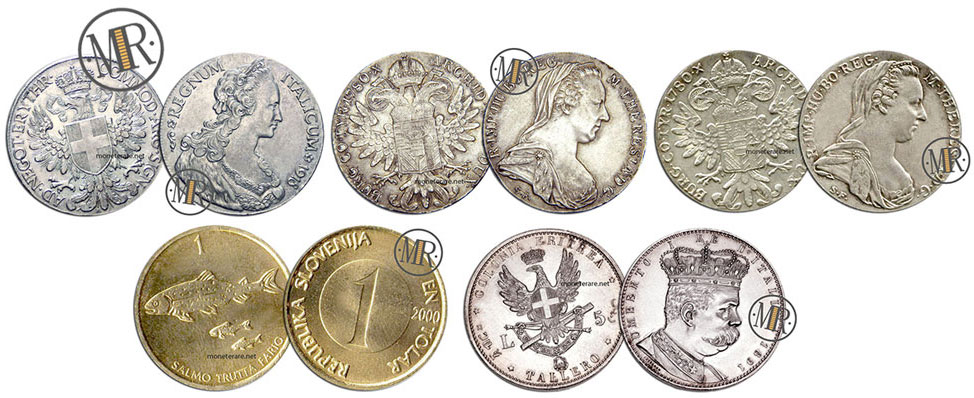
The history of the Thaler coin begins in the mid-1400s, which is when we can trace back to an early form of the Thaler. This coin underwent many variations, leading to the famous Maria Theresa Thaler, a large silver coin widely used in the Eastern countries and Africa.
Let us explore the various types of thalers, their rarity, and, of course, their value.
Introduction to the Thaler Coin
To find the origins of the Thaler coin, we need to go back to the late 15th century, when large silver coins called Guldiners began to circulate in Germanic countries.
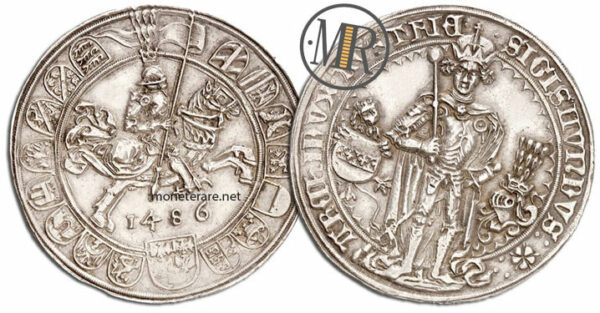
In 1486, Archduke Sigismund of Tyrol initiated the minting of Guldengroschen or Guldiners. From then on, these coins gained such success that many other states began to mint them.
The Meaning of Thaler
The name Thaler originates from the Joachimsthaler, large silver coins minted in Bohemia from 1520 in the valley (thal) of St. Joachim, where new silver mines were discovered and a mint was established.
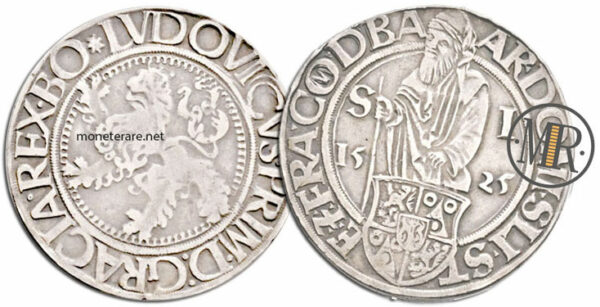
On the obverse of these large silver coins, the rampant lion of Bohemia is depicted, while on the reverse, St. Joachim is illustrated. From Joachimsthaler, the name evolved to simply Thaler, and eventually Taler, or Thaler.
The Maria Theresa Thaler
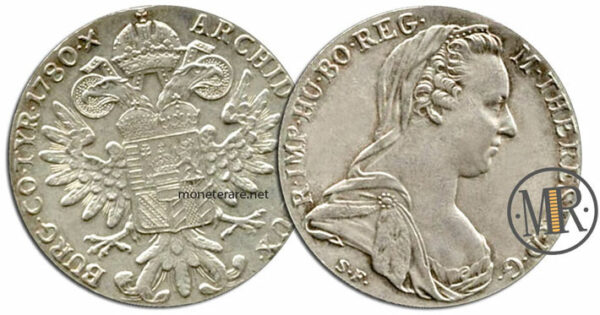
Until about 1750, when the Konventionstaler was introduced, there were many thalers minted by various states, including several Italian states. However, we will discuss these later on this page.
Let us now talk about the Maria Theresa Thaler of 1780 and its importance and widespread use.
A fun fact worth noting is that the Maria Theresa Thaler of Austria is a coin still used today in some African and Middle Eastern countries.
Description of the Maria Theresa Thaler of Austria
Since 1780, the year of Maria Theresa of Austria’s death, the Maria Theresa Thaler has not changed its depictions on the obverse and reverse, always bearing the year 1780.
The Maria Theresa Thaler minted by the Vienna Mint is a large silver coin, with a thickness of 2.5 millimeters and a diameter of 39.5 millimeters.
The total weight of this Maria Theresa Thaler is 28.0668 grams, of which 23.3795 grams are silver, corresponding to a fineness of 833/1000.
On the reverse, the profile of Queen Maria Theresa of Austria is depicted facing right, with her head covered by a veil and a button securing her garment.
In a circular inscription, the text reads, “M • THERESIA • D • G • R • IMP • HU • BO • REG •,” and below the Empress’s bust are the letters “S • F •,” initials of the officials from the Günzburg Mint.
On the obverse, the coin’s field is filled with the double-headed eagle of the Austro-Hungarian Empire, bearing the Habsburg coat of arms on its chest.
Around the edge, the inscription reads, “ARCHID • AUST • DUX • BURG • CO • TYR • 1780 • X.”
History of the 1780 Maria Theresa Thaler
Since its introduction, the Maria Theresa Thaler has experienced widespread use worldwide, quickly becoming one of the most widely circulated coins.
It was minted, always maintaining the same characteristics, by numerous mints, including:
- Birmingham
- Bombay
- London
- Paris
- Utrecht
- Brussels
- Hall
- Günzburg
- Karlsburg
- Kremnitz
- Prague
- Vienna
In Italy, it was minted:
- In Milan from 1790 to about 1840.
- In Venice from 1815 to 1866.
Following an agreement with Austria (July 9, 1935), the use of the Maria Theresa Thaler minting dies was granted to Italy for 25 years, and the mint in Rome resumed minting for trade with the Middle East.
Value of the Maria Theresa Thaler of Austria
The Maria Theresa Thalers minted in Rome are classified as common, while those from Milan and Venice have a rarity ranging from R2 to R5 for those minted in Venice in 1815.
- A Thaler from the mint in Rome can be purchased in online auctions for around €50 (like this closed auction), while a Maria Theresa Thaler from Venice in 1815 is much rarer and will have a significantly higher value.
The Eritrean Thaler
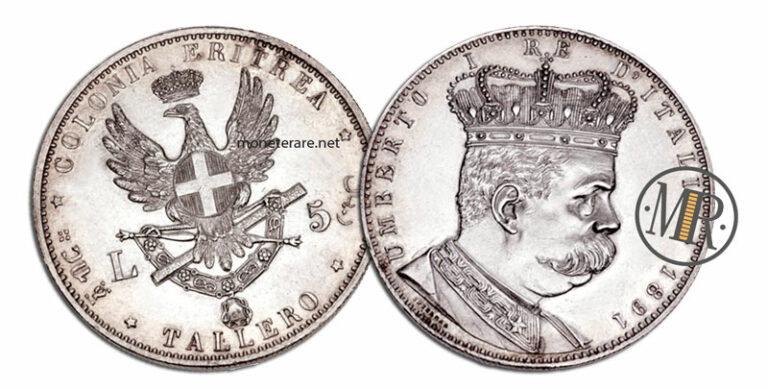
In Eritrea, the Maria Theresa Thaler had already been in circulation for a long time. In 1890, following the annexation of Eritrea as a colony of the Kingdom of Italy, it was decided to mint coins similar to the Thaler, valued at 5 lire.
Description of the Eritrean Thaler
The Eritrean Thaler differs from the traditional Maria Theresa Thaler in several ways, starting with its silver content, which is 900/1000.
It weighs 28.125 grams and has a diameter of 40 millimeters. The edge is reeded.
On the obverse, the crowned profile of King Umberto I is depicted. Below the bust, the author’s signature “SPERANZA” (Filippo Speranza) is visible, and in a circular inscription around the edge, it reads “UMBERTO I RE D’ITALIA •.”
On the reverse, the coin features the Savoy eagle with the royal crown. The eagle grips a scepter and a staff adorned with the collar of the Annunziata. The denomination “L.5” is placed on the left (in Amharic) and right (in Arabic) of the eagle. Around the edge, it reads “COLONIA ERITREA” at the top and “TALLERO” at the bottom.
History of the Eritrean Thaler
These Eritrean Thalers were minted only in the years 1891 (in 195,999 pieces) and 1896 (in 200,000 pieces).
Numerous counterfeits of the Eritrean Thaler are known, so caution is advised.
Value of the Eritrean Thaler
Both the 1891 and 1896 Eritrean Thalers are classified as rare.
- An Eritrean Thaler from 1891 in FDC condition was sold at auction in 2015 for €2,950.
- The 1896 Eritrean Thalers can also fetch prices well above €1,000.
If you own rare coins like these (or even other rarer coins), you can have fun and make money by auctioning them online. We always use this partner site to buy and sell coins at auction. It’s the largest online coin auction platform, and we highly recommend it. Auctioning coins, whether selling or buying, is easy and exciting
The Italian Thaler
Many pre-unification Italian states minted coins similar to the Thaler during the 16th and 17th centuries, primarily for trade in the East.
The Thaler was minted by the House of Savoy, in Modena by the Este family, in Desana by the Tizzone family, in Florence by the Medici, and in Genoa, Mantua, Parma, Ragusa, and other regions.
In this article, however, we will focus exclusively on the Thalers minted by the Kingdom of Italy.
The Italian Thaler (or Italicum)
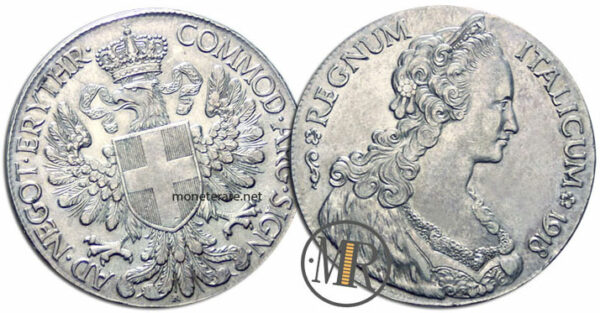
In 1918, an attempt was made to mint a new Thaler, known as the Italian Thaler or Italicum.
Description of the Italian Thaler
The Italian Thaler, or Italicum, has a diameter of 40 millimeters and weighs 28.07 grams, with a silver content of 835/1000.
On the obverse, the coin features a female bust facing right, wearing a diadem with three pendants and an ermine cloak. Around the edge, the inscription reads “REGNUM ITALICUM 1918,” with the author’s signature “MOTTI” at the bottom.
On the reverse, a crossed shield appears on the chest of the Savoy eagle wearing the royal crown. Circular inscriptions read “AD • NEGOT • ERYTHR • COMMOD • ARG • SIGN •,” and the mint mark “R” is visible at the lower left.
History of the Italian Thaler
These Thalers minted by the Kingdom of Italy for trade with the Eritrean colony did not achieve significant success.
Due to differences between the Italicum and the Maria Theresa Thaler, local populations rejected this new coin, which was minted only in 1918 in 510,000 specimens.
Value of the Italian Thaler
- This coin, the Italian Thaler, is classified as uncommon. Its value in FDC or near-FDC condition is high. In 2015, one was purchased at a coin auction for over €1,800!
The Italian Maria Theresa Thaler
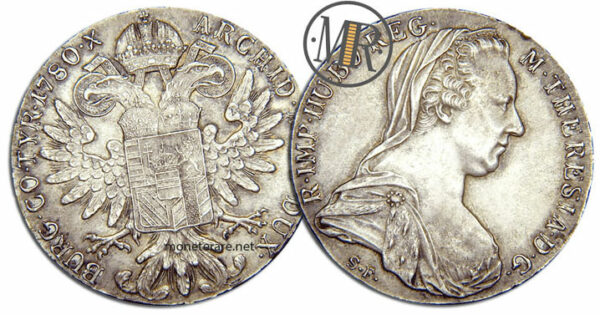
As mentioned earlier, following the 1935 agreements with Austria, minting of Thalers resumed for trade with the colonies, this time using the same designs as the Austrian Thalers.
Description of the Italian Maria Theresa Thaler
These Thalers minted in Rome differ from those minted in Vienna due to a higher silver content (835/1000 instead of 833) and a slightly smaller diameter (40 millimeters instead of 42).
On the obverse, the double-headed eagle with the Habsburg coat of arms on its chest is depicted, surrounded by the inscription “ARCHID • AUST • DUX • BURG • CO • TYR • 1780 • X.”
Notable differences from the Vienna design include the arrangement of the tail feathers (one at the top, three in the middle, and one at the bottom) and the two outermost tail feathers.
On the reverse, the bust of Maria Theresa is shown, with the circular inscription reading “M • THERESIA • D • G • R • IMP • HU • BO • REG •.”
History of the Italian Maria Theresa Thaler
These Thalers were minted, as noted, starting from 1935 and continuing until 1950.
In 1961, Italy returned a pair of dies to the Austrian mint, while a second pair was transferred to the Museum of the Mint in Rome.
Value of the Italian Maria Theresa Thaler
- The mintage of these Italian Maria Theresa Thalers from 1935 to 1939 amounted to 19,446,729 pieces, and this Thaler is classified as common.
This makes it a more accessible coin; in FDC quality, it can reach a value of €120.
The Slovenian Thaler (Tolar)
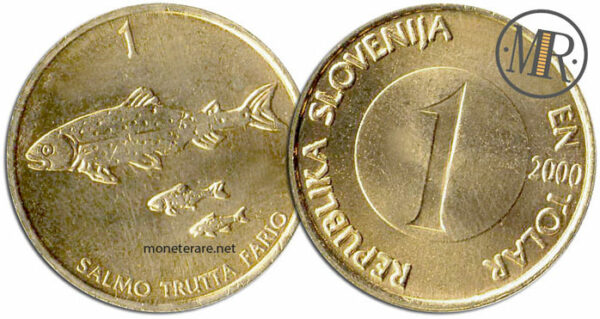
The last European nation to abandon the use of the Thaler was Slovenia in 2006.
Indeed, from January 1, 2007, Slovenia replaced the use of the Tolar (derived from the German Thaler – Thaler) with the Euro, the European single currency.
Description of the Slovenian Tolar
The Slovenian Tolar is a brass coin measuring 22 millimeters in diameter and weighing 4.50 grams.
On the obverse of the 1 Tolar coin, the value 1 is centered within a circle. The inscription “REPUBLIKA SLOVENJIA” appears on the left, and “EN TOLAR” on the right. Between the words “EN” and “TOLAR,” the minting year is visible.
On the reverse of the 1 Tolar coin, some specimens of Brown Trout are depicted. At the top is the value 1, and at the bottom, the Latin name of the subspecies, “SALMO TRUTTA FARIO.”
History of the Slovenian Thaler
In Slovenia, Thaler coinage began in 1991 and continued, as noted, until 2006.
Coins were minted in denominations of 1, 2, 5, 10, 20, and 50 Tolar, as well as 10, 20, and 50 Stotin, the fractional unit of the Tolar.
On the reverse of each of these nine coins, nine typical animals of Slovenia are represented.
These are:
- 10 Stotin – Olm (Proteus anguinus)
- 20 Stotin – Long-eared Owl (Asio otus)
- 50 Stotin – Honeybee (Apis mellifera)
- 1 Tolar – Brown Trout (Salmo trutta fario)
- 2 Tolar – Barn Swallow (Hirundo rustica)
- 5 Tolar – Alpine Ibex (Capra ibex)
- 10 Tolar – Lipizzaner Horse (Equus)
- 20 Tolar – White Stork (Ciconia ciconia)
- 50 Tolar – Bull (Taurus taurus)
Coins of 100 and 500 Tolar were also minted, but did not feature animals on the reverse.
Value of the Slovenian Thaler
The 1 Tolar coins minted from 1992 to 2001 and those from 2004 are considered common.
- However, the coins from 2002, 2003, 2005, and 2006, issued only as divisional sets with very limited mintages, are considered rare.
These coins, however, do not hold significant value in euros, making them easily accessible to collectors. - A Slovenian Thaler from 2006 is valued at around €4.
How to Identify a Counterfeit Thaler
Both the Thalers from 1918 and those from Eritrea have counterfeit versions.
These counterfeits can be identified by several details that a keen numismatist can detect.
The reliefs of the figures and inscriptions are less pronounced compared to the originals, and weight is another reliable indicator.
The “Italicum” Thaler of 1918 weighs 28.07 grams, whereas counterfeits weigh only 26.25 grams! The same applies to the Eritrean Thaler. The original weighs 28.12 grams, while the counterfeit weighs only 27.30 grams.
Therefore, always exercise caution when purchasing coins and rely on trusted platforms that guarantee coin authenticity.
